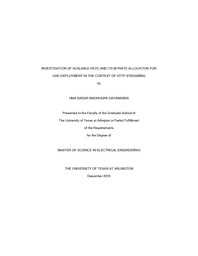
ATTENTION: The works hosted here are being migrated to a new repository that will consolidate resources, improve discoverability, and better show UTA's research impact on the global community. We will update authors as the migration progresses. Please see MavMatrix for more information.
Show simple item record
| dc.contributor.advisor | Rao, Kamisetty R. | |
| dc.creator | Madhugiri Dayananda, Uma Sagar | |
| dc.date.accessioned | 2016-01-27T00:15:17Z | |
| dc.date.available | 2016-01-27T00:15:17Z | |
| dc.date.created | 2015-12 | |
| dc.date.issued | 2015-12-07 | |
| dc.date.submitted | December 2015 | |
| dc.identifier.uri | http://hdl.handle.net/10106/25478 | |
| dc.description.abstract | High Efficiency Video Coding (HEVC/H.265) [1] is the state of the art video compression standard, which provides bitrate reduction in the range of 50% when compared to the previous Advanced Video Coding (AVC/H.264) [5] standard at similar video quality. Scalable High Efficiency Video Coding (SHVC) [2] is the scalable extension of HEVC, which provides traditional scalability options in terms of quality, spatial resolution and temporal frame rate and newer scalability options as well. SHVC can be used to deliver Ultra High Definition (UHD) or 4K resolution video content to mix of clients having varying characteristics.
The distribution of clients is today’s multimedia environment is heterogeneous, as there are televisions, computers and mobile devices, supporting different codecs (AVC or HEVC), resolutions (UHD, HD or SD) and varying bandwidth characteristics. To efficiently deliver video content to heterogeneous clients having varying characteristics, a combination of these state of the art video coding (SHVC) and streaming technologies (MPEG-DASH) can be employed.
Traditionally, multiple versions of the same video are stored on the servers to satisfy varying client characteristics and are delivered using simulcast coding. This leads to increased video bitrates and hence increases storage costs. However, using scalable video coding such as SHVC - where multiple versions of the video are embedded into different layers of the bit stream, results in bitrate savings. This bitrate savings come at a cost of reduced coding efficiency due to addition of layers, known as scalability overhead.
The primary focus of the thesis is investigation of bitrate savings and the scalability overhead incurred during encoding of UHD video content as SHVC enhancement layer with HEVC or AVC as HD base layer and obtaining a methodology for comparison of scalable codec such as SHVC with other codecs. Experiments are conducted for SHVC encoding with fixed bitrate allocation into base layer (BL) and enhancement layer (EL) for two and three layers, concentrating on spatial and quality scalability.
Additional experiments for two layered SHVC encoding are performed by varying the bitrate allocation into BL and EL exploring spatial scalability.
The heuristic method of bitrate allocation for scalable video coding considering both bitrate savings and scalability overhead is a tedious process and error prone. In order to effectively satisfy clients with varying bandwidth characteristics in the context of HTTP video streaming, an optimal SHVC bitrate allocation is necessary. Hence, a, existing bit rate allocation problem for scalable video coding is reviewed, adapted and evaluated for the scenario of UHD deployment with SHVC for optimal bitrate allocation with two layers. | |
| dc.format.mimetype | application/pdf | |
| dc.language.iso | en_US | |
| dc.subject | SHVC | |
| dc.subject | UHD | |
| dc.subject | Scalable HEVC | |
| dc.subject | HTTP streaming | |
| dc.subject | Bitrate allocation | |
| dc.title | INVESTIGATION OF SCALABLE HEVC AND ITS BITRATE ALLOCATION FOR UHD DEPLOYMENT IN THE CONTEXT OF HTTP STREAMING | |
| dc.type | Thesis | |
| dc.contributor.committeeMember | Manry, Michael T. | |
| dc.contributor.committeeMember | Dillon, William E. | |
| dc.date.updated | 2016-01-27T00:17:24Z | |
| thesis.degree.department | Electrical Engineering | |
| thesis.degree.grantor | The University of Texas at Arlington | |
| thesis.degree.level | Masters | |
| thesis.degree.name | Master of Science in Electrical Engineering | |
| dc.type.material | text | |
| dc.creator.orcid | 0000-0001-8602-0982 | |
Files in this item
- Name:
- MADHUGIRIDAYANANDA-THESIS-2015.pdf
- Size:
- 16.86Mb
- Format:
- PDF
This item appears in the following Collection(s)
Show simple item record


